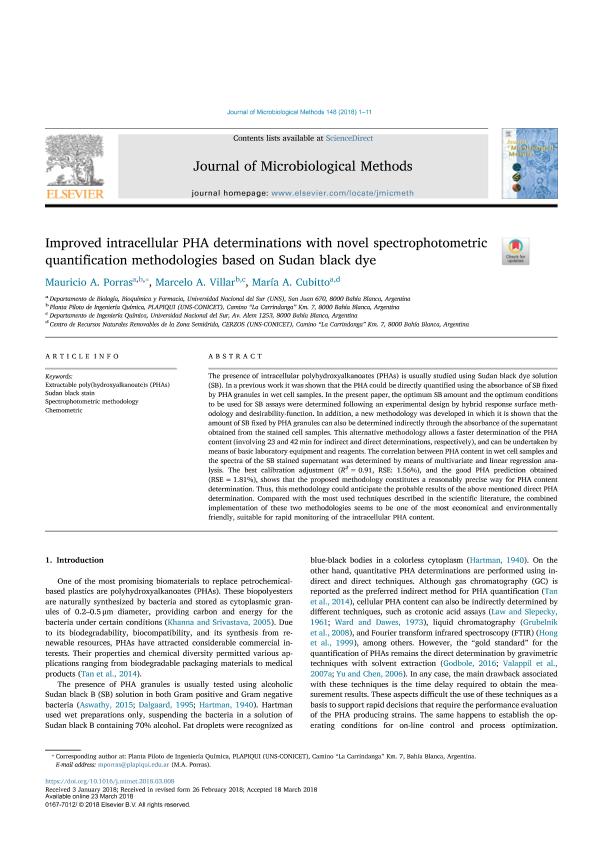Mostrar el registro sencillo del ítem
dc.contributor.author
Porras, Mauiricio Ariel

dc.contributor.author
Villar, Marcelo Armando

dc.contributor.author
Cubitto, María Amelia

dc.date.available
2019-11-05T19:11:27Z
dc.date.issued
2018-05
dc.identifier.citation
Porras, Mauiricio Ariel; Villar, Marcelo Armando; Cubitto, María Amelia; Improved intracellular PHA determinations with novel spectrophotometric quantification methodologies based on Sudan black dye; Elsevier Science; Journal of Microbiological Methods; 148; 5-2018; 1-11
dc.identifier.issn
0167-7012
dc.identifier.uri
http://hdl.handle.net/11336/88064
dc.description.abstract
The presence of intracellular polyhydroxyalkanoates (PHAs) is usually studied using Sudan black dye solution (SB). In a previous work it was shown that the PHA could be directly quantified using the absorbance of SB fixed by PHA granules in wet cell samples. In the present paper, the optimum SB amount and the optimum conditions to be used for SB assays were determined following an experimental design by hybrid response surface methodology and desirability-function. In addition, a new methodology was developed in which it is shown that the amount of SB fixed by PHA granules can also be determined indirectly through the absorbance of the supernatant obtained from the stained cell samples. This alternative methodology allows a faster determination of the PHA content (involving 23 and 42 min for indirect and direct determinations, respectively), and can be undertaken by means of basic laboratory equipment and reagents. The correlation between PHA content in wet cell samples and the spectra of the SB stained supernatant was determined by means of multivariate and linear regression analysis. The best calibration adjustment (R2 = 0.91, RSE: 1.56%), and the good PHA prediction obtained (RSE = 1.81%), shows that the proposed methodology constitutes a reasonably precise way for PHA content determination. Thus, this methodology could anticipate the probable results of the above mentioned direct PHA determination. Compared with the most used techniques described in the scientific literature, the combined implementation of these two methodologies seems to be one of the most economical and environmentally friendly, suitable for rapid monitoring of the intracellular PHA content. presence of intracellular polyhydroxyalkanoates (PHAs) is usually studied using Sudan black dye solution (SB). In a previous work it was shown that the PHA could be directly quantified using the absorbance of SB fixed by PHA granules in wet cell samples. In the present paper, the optimum SB amount and the optimum conditions to be used for SB assays were determined following an experimental design by hybrid response surface methodology and desirability-function. In addition, a new methodology was developed in which it is shown that the amount of SB fixed by PHA granules can also be determined indirectly through the absorbance of the supernatant obtained from the stained cell samples. This alternative methodology allows a faster determination of the PHA content (involving 23 and 42 min for indirect and direct determinations, respectively), and can be undertaken by means of basic laboratory equipment and reagents. The correlation between PHA content in wet cell samples and the spectra of the SB stained supernatant was determined by means of multivariate and linear regression analysis. The best calibration adjustment (R2 = 0.91, RSE: 1.56%), and the good PHA prediction obtained (RSE = 1.81%), shows that the proposed methodology constitutes a reasonably precise way for PHA content determination. Thus, this methodology could anticipate the probable results of the above mentioned direct PHA determination. Compared with the most used techniques described in the scientific literature, the combined implementation of these two methodologies seems to be one of the most economical and environmentally friendly, suitable for rapid monitoring of the intracellular PHA content.
dc.format
application/pdf
dc.language.iso
eng
dc.publisher
Elsevier Science

dc.rights
info:eu-repo/semantics/openAccess
dc.rights.uri
https://creativecommons.org/licenses/by-nc-sa/2.5/ar/
dc.subject
CHEMOMETRIC
dc.subject
EXTRACTABLE POLY(HYDROXYALKANOATE)S (PHAS)
dc.subject
SPECTROPHOTOMETRIC METHODOLOGY
dc.subject
SUDAN BLACK STAIN
dc.subject.classification
Biología Celular, Microbiología

dc.subject.classification
Ciencias Biológicas

dc.subject.classification
CIENCIAS NATURALES Y EXACTAS

dc.title
Improved intracellular PHA determinations with novel spectrophotometric quantification methodologies based on Sudan black dye
dc.type
info:eu-repo/semantics/article
dc.type
info:ar-repo/semantics/artículo
dc.type
info:eu-repo/semantics/publishedVersion
dc.date.updated
2019-10-17T14:27:42Z
dc.journal.volume
148
dc.journal.pagination
1-11
dc.journal.pais
Países Bajos

dc.journal.ciudad
Amsterdam
dc.description.fil
Fil: Porras, Mauiricio Ariel. Consejo Nacional de Investigaciones Científicas y Técnicas. Centro Científico Tecnológico Conicet - Bahía Blanca. Planta Piloto de Ingeniería Química. Universidad Nacional del Sur. Planta Piloto de Ingeniería Química; Argentina. Universidad Nacional del Sur. Departamento de Biología, Bioquímica y Farmacia; Argentina
dc.description.fil
Fil: Villar, Marcelo Armando. Consejo Nacional de Investigaciones Científicas y Técnicas. Centro Científico Tecnológico Conicet - Bahía Blanca. Planta Piloto de Ingeniería Química. Universidad Nacional del Sur. Planta Piloto de Ingeniería Química; Argentina. Universidad Nacional del Sur. Departamento de Ingeniería Química; Argentina
dc.description.fil
Fil: Cubitto, María Amelia. Consejo Nacional de Investigaciones Científicas y Técnicas. Centro Científico Tecnológico Conicet - Bahía Blanca. Centro de Recursos Naturales Renovables de la Zona Semiárida. Universidad Nacional del Sur. Centro de Recursos Naturales Renovables de la Zona Semiárida; Argentina. Universidad Nacional del Sur. Departamento de Biología, Bioquímica y Farmacia; Argentina
dc.journal.title
Journal of Microbiological Methods

dc.relation.alternativeid
info:eu-repo/semantics/altIdentifier/url/http://linkinghub.elsevier.com/retrieve/pii/S0167701218302033
dc.relation.alternativeid
info:eu-repo/semantics/altIdentifier/doi/http://dx.doi.org/10.1016/j.mimet.2018.03.008
Archivos asociados
